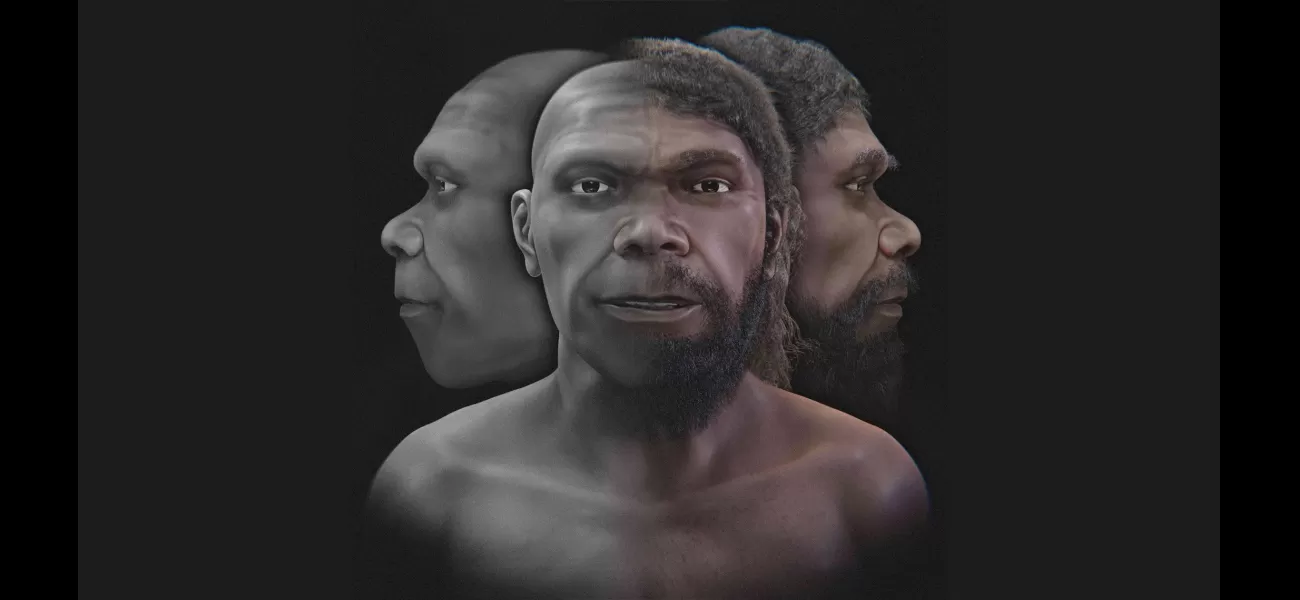After 300,000 years, the appearance of the oldest human has been unveiled.
He is powerful and calm.
June 19th 2024.

Have you ever pondered what our ancestors may have looked like over 300,000 years ago? Well, the answer is finally here. The face of our oldest known human relative has been reconstructed for the first time, giving us a glimpse into the past. This man, described as 'strong and serene', has been brought back to life thanks to the incredible work of Brazilian graphics expert Cicero Moraes. Using a 3D scan of the skull, Moraes was able to create a realistic representation of our ancient ancestor.
The skull used for this reconstruction was found at the Jebel Irhoud site in Morocco, hence its name. It has proven to be a groundbreaking discovery, as it shows that humans, or Homo sapiens, evolved much earlier than previously thought - a whopping 100,000 years earlier, to be exact. This also means that our ancestors did not originate solely from east Africa, as previously believed. They spread across the continent much earlier than what previous evidence had suggested.
So how exactly did Moraes go about this reconstruction? He explains, "Initially, I scanned the skull in 3D, using data provided by researchers from the Max Planck Institute. Then, I used various techniques, such as anatomical deformation, to create the facial approximation." This involved mapping the 3D skull onto a 'donor' skull prototype, which was based on an adult male with a low body mass index. Moraes chose to give the reconstructed skull a male face, based on the robust and masculine features of the original.
To make the face as realistic as possible, Moraes also used data from modern humans to predict the thickness of the soft tissue and the likely projection of the nose and other facial structures. This resulted in two groups of images - one objective, with technical elements and no hair, and the other artistic, with pigmentation and hair. The final result was a composite of various fossils, pieced together to create a coherent and anatomically accurate representation.
The Max Planck Institute, which provided the data for the skull, stated that the Jebel Irhoud remains had a modern-looking face and teeth, but a more archaic-looking braincase. They believe that changes in genetics have transformed our braincases into what they are today. Moraes also agrees with this, comparing the Jebel Irhoud skull to the Skhul V skull of an archaic Homo sapiens. He finds it fascinating to observe the differences and similarities between these skulls and faces over thousands of years.
The fossils at the Jebel Irhoud site were initially discovered in the 1960s and were estimated to be around 40,000 years old. However, after a revisit and the use of new techniques, scientists were able to determine that the bones were actually approximately 300,000 years old. Jean-Jacques Hublin, from the Max Planck Institute, commented on the discovery, stating, "We used to believe that the cradle of mankind was 200,000 years ago in east Africa. But the truth is that Homo sapiens spread across the entire African continent even earlier, around 300,000 years ago." This groundbreaking discovery has now surpassed the previously oldest known Homo sapiens remains found in Omo Kibish, Ethiopia, which were dated to be 195,000 years old.
Thanks to the incredible work of Cicero Moraes and the use of advanced technology, we are now able to get a glimpse into the appearance of our oldest known ancestor. This discovery has shed new light on the evolution of humans and their migration across the African continent, challenging previous beliefs. Who knows what other secrets of our past will be revealed in the future.
The skull used for this reconstruction was found at the Jebel Irhoud site in Morocco, hence its name. It has proven to be a groundbreaking discovery, as it shows that humans, or Homo sapiens, evolved much earlier than previously thought - a whopping 100,000 years earlier, to be exact. This also means that our ancestors did not originate solely from east Africa, as previously believed. They spread across the continent much earlier than what previous evidence had suggested.
So how exactly did Moraes go about this reconstruction? He explains, "Initially, I scanned the skull in 3D, using data provided by researchers from the Max Planck Institute. Then, I used various techniques, such as anatomical deformation, to create the facial approximation." This involved mapping the 3D skull onto a 'donor' skull prototype, which was based on an adult male with a low body mass index. Moraes chose to give the reconstructed skull a male face, based on the robust and masculine features of the original.
To make the face as realistic as possible, Moraes also used data from modern humans to predict the thickness of the soft tissue and the likely projection of the nose and other facial structures. This resulted in two groups of images - one objective, with technical elements and no hair, and the other artistic, with pigmentation and hair. The final result was a composite of various fossils, pieced together to create a coherent and anatomically accurate representation.
The Max Planck Institute, which provided the data for the skull, stated that the Jebel Irhoud remains had a modern-looking face and teeth, but a more archaic-looking braincase. They believe that changes in genetics have transformed our braincases into what they are today. Moraes also agrees with this, comparing the Jebel Irhoud skull to the Skhul V skull of an archaic Homo sapiens. He finds it fascinating to observe the differences and similarities between these skulls and faces over thousands of years.
The fossils at the Jebel Irhoud site were initially discovered in the 1960s and were estimated to be around 40,000 years old. However, after a revisit and the use of new techniques, scientists were able to determine that the bones were actually approximately 300,000 years old. Jean-Jacques Hublin, from the Max Planck Institute, commented on the discovery, stating, "We used to believe that the cradle of mankind was 200,000 years ago in east Africa. But the truth is that Homo sapiens spread across the entire African continent even earlier, around 300,000 years ago." This groundbreaking discovery has now surpassed the previously oldest known Homo sapiens remains found in Omo Kibish, Ethiopia, which were dated to be 195,000 years old.
Thanks to the incredible work of Cicero Moraes and the use of advanced technology, we are now able to get a glimpse into the appearance of our oldest known ancestor. This discovery has shed new light on the evolution of humans and their migration across the African continent, challenging previous beliefs. Who knows what other secrets of our past will be revealed in the future.
[This article has been trending online recently and has been generated with AI. Your feed is customized.]
[Generative AI is experimental.]
0
0
Submit Comment





